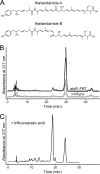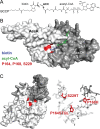Thailandamide, a Fatty Acid Synthesis Antibiotic That Is Coexpressed with a Resistant Target Gene
- PMID: 29914944
- PMCID: PMC6125523
- DOI: 10.1128/AAC.00463-18
Thailandamide, a Fatty Acid Synthesis Antibiotic That Is Coexpressed with a Resistant Target Gene
Abstract
Microbes encode many uncharacterized gene clusters that may produce antibiotics and other bioactive small molecules. Methods for activating these genes are needed to explore their biosynthetic potential. A transposon containing an inducible promoter was randomly inserted into the genome of the soil bacterium Burkholderia thailandensis to induce antibiotic expression. This screen identified the polyketide/nonribosomal peptide thailandamide as an antibiotic and discovered its regulator, AtsR. Mutants of Salmonella resistant to thailandamide had mutations in the accA gene for acetyl coenzyme A (acetyl-CoA) carboxylase, which is one of the first enzymes in the fatty acid synthesis pathway. A second copy of accA in the thailandamide synthesis gene cluster keeps B. thailandensis resistant to its own antibiotic. These genetic techniques will likely be powerful tools for discovering other unusual antibiotics.
Keywords: Burkholderia thailandensis; acetyl-CoA carboxylase; antimicrobial; global regulator; polyketide.
Copyright © 2018 American Society for Microbiology.
Figures







Similar articles
-
A coevolution experiment between Flavobacterium johnsoniae and Burkholderia thailandensis reveals parallel mutations that reduce antibiotic susceptibility.Microbiology (Reading). 2023 Feb;169(2):001267. doi: 10.1099/mic.0.001267. Microbiology (Reading). 2023. PMID: 36724091 Free PMC article.
-
The Polyene Natural Product Thailandamide A Inhibits Fatty Acid Biosynthesis in Gram-Positive and Gram-Negative Bacteria.Biochemistry. 2018 Jul 24;57(29):4247-4251. doi: 10.1021/acs.biochem.8b00678. Epub 2018 Jul 12. Biochemistry. 2018. PMID: 29975047
-
Induced biosynthesis of cryptic polyketide metabolites in a Burkholderia thailandensis quorum sensing mutant.J Am Chem Soc. 2010 Oct 13;132(40):13966-8. doi: 10.1021/ja105003g. J Am Chem Soc. 2010. PMID: 20853892
-
Pattern and regulation of acetyl-CoA carboxylase gene expression.J Nutr. 1994 Aug;124(8 Suppl):1273S-1283S. doi: 10.1093/jn/124.suppl_8.1273S. J Nutr. 1994. PMID: 7914919 Review.
-
Regulation and structure of the heteromeric acetyl-CoA carboxylase.Biochim Biophys Acta. 2016 Sep;1861(9 Pt B):1207-1213. doi: 10.1016/j.bbalip.2016.04.004. Epub 2016 Apr 16. Biochim Biophys Acta. 2016. PMID: 27091637 Review.
Cited by
-
Do Global Regulators Hold the Key to Production of Bacterial Secondary Metabolites?Antibiotics (Basel). 2019 Sep 23;8(4):160. doi: 10.3390/antibiotics8040160. Antibiotics (Basel). 2019. PMID: 31547528 Free PMC article. Review.
-
Thailandenes, Cryptic Polyene Natural Products Isolated from Burkholderia thailandensis Using Phenotype-Guided Transposon Mutagenesis.ACS Chem Biol. 2020 May 15;15(5):1195-1203. doi: 10.1021/acschembio.9b00883. Epub 2020 Jan 2. ACS Chem Biol. 2020. PMID: 31816232 Free PMC article.
-
Bioactive exometabolites drive maintenance competition in simple bacterial communities.mSystems. 2024 Apr 16;9(4):e0006424. doi: 10.1128/msystems.00064-24. Epub 2024 Mar 12. mSystems. 2024. PMID: 38470039 Free PMC article.
-
Mining Fatty Acid Biosynthesis for New Antimicrobials.Annu Rev Microbiol. 2022 Sep 8;76:281-304. doi: 10.1146/annurev-micro-041320-110408. Epub 2022 Jun 1. Annu Rev Microbiol. 2022. PMID: 35650664 Free PMC article. Review.
-
An in situ high-throughput screen identifies inhibitors of intracellular Burkholderia pseudomallei with therapeutic efficacy.Proc Natl Acad Sci U S A. 2019 Sep 10;116(37):18597-18606. doi: 10.1073/pnas.1906388116. Epub 2019 Aug 22. Proc Natl Acad Sci U S A. 2019. PMID: 31439817 Free PMC article.
References
-
- CDC. 2013. Antibiotic resistance threats in the United States, 2013. CDC, Atlanta, GA: https://www.cdc.gov/drugresistance/pdf/ar-threats-2013-508.pdf.
-
- Palleroni NJ. 2005. Burkholderia, p 575–600. In Garrity GM, Brenner DJ, Krieg NR, Staley JT (ed), Bergey's manual of systematic bacteriology, vol 2 Springer, New York, NY.
-
- Walsh C. 2003. Antibiotics: actions, origins, resistance. ASM Press, Washington, DC.
Publication types
MeSH terms
Substances
Grants and funding
LinkOut - more resources
Full Text Sources
Other Literature Sources
Medical
Miscellaneous

